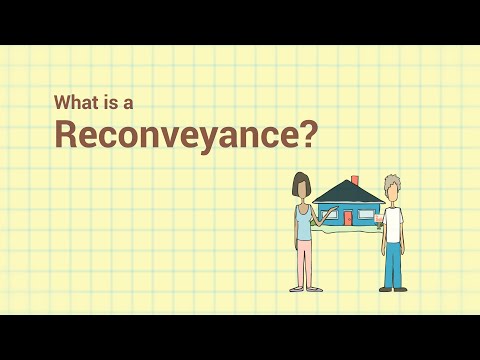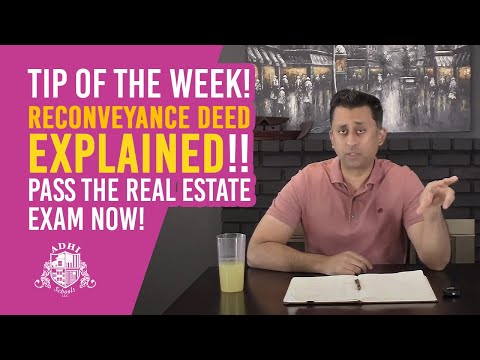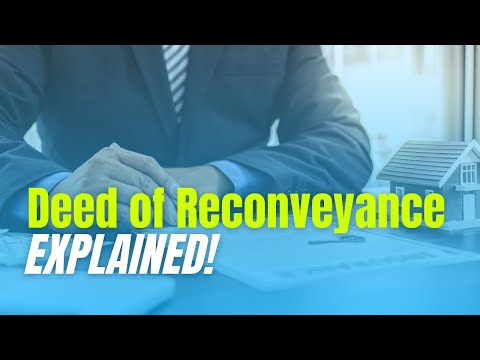Understanding the Reconveyance Deed: The Legal Instrument After Loan Payoff
So, you’ve spread your wings in the homeowners’ world and flitted on the exciting but daunting journey of securing a mortgage. From traversing through the vicissitudes of interest rates to diligently paying installments, and now, at last, you’ve finally achieved the milestone of clearing your home loan.
At this point, a reconveyance deed, also known as a deed of reconveyance, becomes your best friend. There’s more to full home ownership than making your last payment. Breathing a sigh of relief, you’re eager to cut the strings to your lender for good, and rightfully so, you yearn for that stamp of legitimate ownership.
The reconveyance deed marks when you’ve finally climbed the mortgage mountain, signaling you’ve achieved your goal. So, let’s peek under the hood of this instrumental documentation.

Fundamental Aspects of a Deed of Reconveyance
Key Roles in the Reconveyance Process
The reconveyance process is a dance coordinated between three main partners: you, the borrower cum homeowner; the trustee, who governed the lien; and the beneficiary, often your lender or someone acting in their stead. Sorry folks, it’s not a solo gig, yet it all revolves around you getting the keys to your financial freedom.
Drafting and Executing the Deed of Reconveyance
The lender, moving to the beat of your final payment, triggers the trustee to draft a Reconveyance Deed. In this document, critical details such as the homeowner’s name and address, identifier details of the property, and, most importantly, acknowledgment of full repayment are provided. Now, as the bows align for your grand finale, the trustee’s signature need not only be notarized but also recorded in the respective county recorder’s office. The choreography concluded, you breathe a sigh of relief, the papers confirming that your once-encumbered property is now yours outright.
Essential Elements in a Reconveyance Deed
The reconveyance deed isn’t just a piece of paper; it’s the passport to your property independence. From the factual information, such as your name and address and the specifics of your property; to the nitty-gritty of your financial emancipation journey, the deed must clarify what debt was cleared and the confirmation of this repayment, echoing the sweet song of mortgage liberation.

| Subject | Details |
|---|---|
| Definition | A Deed of Reconveyance refers to the legal documentation confirming that a property’s debt secured by a Deed of Trust has been fully paid. |
| Function | It serves to clear the deed of trust from the title to the property once the debt is fully paid off. The ownership is transferred from the mortgage lender to the borrower. |
| Execution | The trustee records the full reconveyance in the county recorder’s office within 21 days after receiving the necessary documents and fee. |
| Key Stakeholders | The primary stakeholders include the trustee, the lender (beneficiary), and the borrower (homeowner/mortgage borrower). |
| Beneficiary Role | The beneficiary, usually the lender or carry back seller, receives no legal interest in the property through the trust deed but acquires an equitable interest due to a secured relationship to the property. |
| Lien Release | Upon loan payoff, the lender removes the lien by signing the back of the Certificate of Title, releasing the title to the borrower. |
| Full Reconveyance Form | This form, which the trustee must complete, sign, and notarize, signifies the completion of the process. The form can be purchased at most office supply or stationery stores. |
| Content of Deed | The deed of reconveyance includes: The homeowner/mortgage borrower’s name and address, the lender/trustee’s name, and a description of the property and parcel number based on the original deed. |
The Reconveyance Procedure: Methodical Steps towards Freedom from Mortgage
Repayment of the Mortgage Loan
The reconveyance procedure is akin to an orchestra where the full payoff of your loan strikes the first note. This vital step sets the stage, instructing lenders and trustees to make moves, setting into motion the required paperwork.
Requesting the Deed of Reconveyance
Once the last installment is paid, you, the borrower, can send a request for the deed of reconveyance. Think of it as the sweet sound of a gong, signaling for the next flow of melody within your financial orchestra.
Filing and Recording the Reconveyance Deed
Next follows the legato flow of the trustee, who files and records the instrument of payment completion. This step is crucial as it leaves a clear path for your future financial endeavors leading to an experience as soothing as calming Treats For Dogs
Addressing Potential Missteps in the Reconveyance Procedure
Like any symphony, occasional hiccups can be expected. Perhaps your trustee is slow in processing, or errors creep in. Keep a vigilant eye and engage the right support, like the experts at Mortgage Rater, who professionally handle brokers’ price opinions to make course corrections.

The Role of a Reconveyance Deed in Closing Your Loan
Significance of a Deed of Reconveyance in Mortgage Industry
The deed of reconveyance might appear to be a trivial piece of paper, but in the mortgage industry, it works as the grand full stop at the end of your loan narrative. With the clarity of reconveyance, lenders can swiftly pursue their next chapter, such as buying debt, assured of your loan closure.
The Reconveyance Deed as Proof of Loan Settlement
Making the last payment doesn’t, in itself, grant full home ownership. Without a reconveyance deed, there is this lingering cloud, akin to constantly questioning, can You refuse To join a Homeowners association Clear the cloud; get that deed.
How the Reconveyance Deed Affects Property Ownership
Boom! Once your reconveyance deed is registered, the curtains fall, heralding the grand finale – property transferred. Your ownership status elevates from vested with a lien to full and undisputed, and there’s no better time than auction time; you call the shots!

Evaluating the Impacts of a Reconveyance on Your Financial Outlook
The Deed of Reconveyance and Credit Score
Your credit score is your financial pulse in the economic world. A reconveyance deed provides a clean slate, and in light of your diligence in clearing the loan, your credit score, my friend, takes an upward leap!
Reconveyance Deed and Future Financing Opportunities
Having cleared your mortgage debt, you’re a worthy bet for lenders. A recorded reconveyance deed increases your borrowing potential and enhances your negotiation power for better loan terms in the future.
Potential Tax Implications with a Deed of Reconveyance
A reconveyance deed, in itself, rarely comes with tax implications. Remember, the tax man has his teeth in the amortization, not the deed itself. Always check on tax rules to stay informed and prepared.

Case Study Analysis: Success Stories of Reconveyance Deed Process
Reconveyance as a Path to Financial Security: Mr. A’s Story
Mr. A slogged through his 15-year mortgage with sweat and tears. As he opened his reconveyance deed, he confided, “Now, my financial security is stamped and sealed!”
The Journey towards Full Home Ownership: Ms. B’s Experience
For Ms. B, the forging of her final loan installment check was a joyous event, yet this got magnified when the reconveyance deed was recorded. Life without a lien was a newfound freedom for her, worth the journey.
Overcoming Mortgage Challenges through Reconveyance: Company C’s Successful Story
Company C achieved a feat when they cleared their commercial property lien. It was tough, but as they hold their reconveyance deed now, they don’t regret a single step.

Expert Suggestions on Navigating a Reconveyance Deed Execution
Foreseeing Possible Challenges in the Reconveyance Process
There’s no sugar-coating it; the process isn’t a cakewalk. Lenders or trustees may delay processing or make mistakes. Yet, if you’re armed with the right knowledge and have a stellar team to assist, you’ll confidently navigate through.
Tips on Ensuring a Smooth Deed of Reconveyance Execution
Patience, vigilance, and diligence are key. Keep track of your payments, assertively request your reconveyance deed, and ensure your trustee executes it on time. The shortcut to your full ownership lies in your hands.
Securing Legal Assistance in a Reconveyance Deed Execution
Sometimes, the legalese becomes overwhelming, or the process grinds to a halt. Here, getting a legal expert involved can save your day, lest the conundrum pushes your financial freedom at arms’ length.
Beyond the Last Installment: The Final Word on the Reconveyance Deed Process
Your last installment is the beginning of a new chapter. That chapter morphs into a fantastic story once it plays out to the tune of the reconveyance deed. While it might seem like a daunting task, it is as imperative as your first home loan application — the deed that puts the bow on your successful mortgage journey. Through it, you don’t only celebrate the sweet taste of full ownership, but it cements your financial credibility – a record of triumph over a significant debt obligation. Go ahead, twirl in the freedom that a deed of reconveyance awards you.
What is the difference between deed of trust and deed of reconveyance?
Ah, great question! So, a deed of trust is basically a document that gives your lender the right to step in if you can’t cover your mortgage payments. On the other hand, a deed of reconveyance is the celebratory finish line – it’s given out when you’ve
paid off your mortgage and it transfers the property title back to you, the homeowner.
Who is responsible for recording a reconveyance?
So, who’s on reconveyance recording duty, you ask? Simple! The trustee. It’s up to them to lay down the facts of the loan payoff in the public records, just to keep everything above board.
Who is the beneficiary on a full reconveyance?
Who’s the lucky beneficiary on a full reconveyance? No drumroll needed – it’s you, the borrower! Now that you’ve paid back the loan, you get to hold the property title once again.
How do I get my title after paying off my mortgage in California?
Eager to get your title after paying off your mortgage in California? All you need is patience. Your lender will issue a deed of reconveyance and it’ll be recorded with the county so everyone knows you’re back in possession.
What is the purpose of a deed of reconveyance?
So, what’s the grand purpose of a deed of reconveyance? It documentary proof that your property is now free of liens. It’s the world’s way of shouting from the rooftops, “This one’s paid off!”
What document do I get after pay off my mortgage?
Straight out of a mortgage payoff, you don’t walk away empty-handed. As your parting gift, you get a satisfaction document or release of lien. This is the golden ticket that shows your debt is fully cleared.
How do I prove my mortgage is paid off?
Want to wave your mortgage payoff like a flag? Easy, just present your satisfaction document or release of lien, and show ’em you’re all square and free of debt.
What is the law of reconveyance?
Here’s the 411 on the law of reconveyance: It’s what dictates the ‘how’ of transferring the property title from the trustee back to the borrower when the loan is fully paid.
Is satisfaction of mortgage the same as a deed?
Satisfaction of mortgage and a deed are sort of like twins – they look identical, but they’re not. Satisfaction of mortgage confirms your debt is paid, while a deed gives you the legal rights to the property.
What deed removes beneficiaries?
A deed of reconveyance is your go-to in removing beneficiaries. Once your mortgage is paid off, this document transfers the title from the trustee back to the homeowner.
Who prepares a reconveyance?
Who whips up a reconveyance? It’s your trustee. They prepare the deed of reconveyance confirming all is settled and you’re clear of your mortgage.
What does a deed of reconveyance look like?
A deed of reconveyance isn’t a mysterious document – it’s pretty straightforward, stating the borrower’s and lender’s names, property’s legal description, and confirms that the loan is paid in full.
Does the bank keep the title until I pay off the house?
In short, yes, the bank holds the title until you’ve paid off the house. It’s their way of protecting their investment until you pay off every dime.
What does reconveyance mean?
Fancy word, reconveyance, huh? Simply put, it’s the process of transferring the property title back to the borrower once their mortgage is fully paid.
How do you clear title to property once the property has been paid for in full in title theory states?
Clearing the title to property in title theory states once it’s paid for in full involves issuing a deed of reconveyance. This legally confirms you’re the rightful owner – free and clear!
What does it mean to reconvey a deed of trust?
Reconveying a deed of trust? That’s just fancy talk for saying you’re transferring the property title from the trustee back to you, the borrow, after paying the loan.
Is a substitution of trustee and full reconveyance the same as a deed?
Substitution of trustee and full reconveyance isn’t the same as a deed. It merely substitutes the trustee and declares the loan as paid, while a deed gives you rightful ownership of the property.
What is the difference between deed of trust and deed?
The difference between a deed of trust and a deed is like night and day. A deed of trust secures the loan, while a deed establishes ownership to the property.
When you pay off your mortgage do you get the deed?
Go you, mortgage payoff champ! Yes, once you wipe out your mortgage, you get the deed, standing proof that you’re the alpha and omega of your property!



